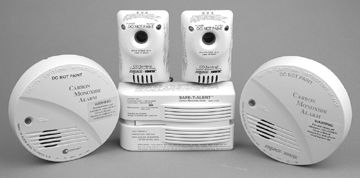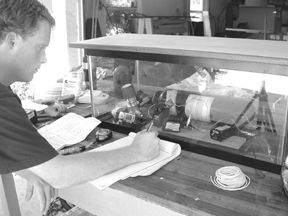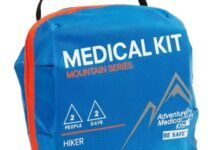
Consider this not-so-unusual scenario: On June 18 this year, a group of friends rafted up three midsize vessels at an idyllic anchorage on Silver Glen Springs in northern Florida. They were intent on spending the night at this placid, popular spot near the Ocala National Forest.
At 5:00 p.m., the generators on all three boats were turned on to power air conditioners for a comfortable night’s sleep belowdecks. Those to port and starboard of the center vessel operated portable generators placed on their swim platforms. The center vessel operated an onboard generator discharging exhaust via a port on the starboard quarter, just above the waterline. A rectangular foam fender was placed between it and the vessel to starboard, which belonged to a young married couple from Orlando.
The group gathered for dinner on the center vessel. They ate and socialized until midnight and then they all retired. At that point the generators had been running for seven hours.
Morning brought what seemed like another perfect summer’s day on the water. But the other boaters became worried after several calls into the young couple’s cabin went unanswered. At 10 a.m., after the couple’s generator had run out of gas, the other boaters climbed aboard and opened the companionway door to find what several had begun to fear—their friends were dead.
The subsequent investigation concluded that the couple had succumbed to CO poisoning not long after they had gone to bed the night before. EMS personnel who arrived on the scene later found the CO concentration in their cabin to be 36 ppm, this after the forward hatch and companionway door had been opened.
Investigators later recreated the accident to determine exactly what caused CO to build to lethal levels. Their report cited several contributing factors. All three boats were operating generators, which exponentially increased the concentration of ambient CO (in the form of exhaust fumes) . They were also moored abeam of the wind and current. This configuration allowed the breeze to push the CO toward the leeward boat, instead of ventilating all of the boats had they been moored head-to-wind.
The largest source of CO was the center vessel’s generator exhaust port. Fumes from that were channeled behind the fender and into the cockpit of the victims’ boat. Then, the investigators theorized, the cooler air-conditioned cabin became an area of low pressure that drew the warmer, exhausted-laden air inside. CO then accumulated over a course of several hours. A CO detector was in the victim’s cabin, but it was not connected to the ship’s power. According to a friend, too many nuisance alarms had prompted the couple to disconnect it some time earlier.
Unfortunately, scenarios like the one described here can happen all too easily. Carbon monoxide is a cumulative poison. A byproduct of combustion and a major component of exhaust fumes, when inhaled, CO bonds with oxygen-carrying hemoglobin molecules in the blood, inhibiting your body’s ability to absorb and circulate O2 . As the concentration of CO in your body increases, your body becomes less and less able to oxygenate tissue.
Over time, even mild exposure to CO—concentrations below 100 parts per million (ppm)—can result in dizziness, disorientation, headache, and nausea. Prolonged heavy exposure will make you chemically hypoxic, leading to seizures, brain damage, and death, if left untreated.
A quick scan of U.S. Coast Guard statistics on injuries and deaths related to carbon monoxide poisoning may leave readers happily complacent—there were just 20 incidents reported nationwide in 2003, which are the most recent figures available. Compared with the myriad other hazards sailors have to contend with, CO poisoning probably ranks low on anyone’s list of things to worry about. But any vessel with confined spaces and equipment that produces a flame or exhaust fumes is potentially at risk. Having a marine CO detector on board can be a wise investment if your boat meets those criteria. (It should be noted that diesel engines produce fewer ppm of CO than gas engines, but some ppm nonetheless.)
Marine CO detectors tend to engender love-hate relationships. They aren’t cheap; UL certified marine devices like some of the ones we tested cost between $45 and $190. Though the UL standards require that these products be more durable than their domestic counterparts, their sensors are perishable and need to be regularly re-calibrated. Also, their sensors can be fouled by extreme temperatures and humidity, as well as a number of chemical vapors. Of course nuisance alarms have been the cause of much eye rolling and faintly muttered profanity. However, when CO builds to dangerous concentrations in your cabin, galley, engine compartment, or a cockpit enclosed with canvas, a properly functioning detector can save your life.
What We Tested, and How
Marine-specific CO detectors are distinguished by their UL approval for use in marine environments. UL 2034 is the specific standard for marine CO detectors. It was most recently revised in 2003 to make detectors less susceptible to damage when exposed to ammonia, acetone, ethanol, toluene, and trichloroethane outgases. To gain UL approval for marine use, detectors must perform well during rigorous testing that is designed to mimic the harsh marine environment, which includes hard impacts and dramatic changes in temperature and humidity.
PS tested four UL approved marine devices: the Safe-T-Alert from Marine Technology Industries, based in Volo, IL ($55), and three models from Fireboy/Xintex, based in Grand Rapids, MI; the CO Sentinel ($157), the CO Sentinel with generator shutoff and multiple detector interface capability ( $190), and the 9V battery-powered, surface-mount model ($146).
PS also tested a 9V surface-mount detector from The Quantum Group, based in San Diego, CA, called the CO Star Marine ($68), which is marketed as a marine detector. Although it does not have UL certification, it is endorsed by the Recreation Vehicle Industry Association.
To gain a sense for how well these devices work, we placed each one in a sealed, 15-gallon fish tank and exposed them to reagent-grade carbon monoxide we purchased from a commercial gas supplier. For low-level testing, the regulator on our CO bottle actually leaked just enough gas around its valve seat to slowly fill the tank to 50 PPM and higher. For benchmarking, we used two portable detectors with digital displays that show the ppm concentration of CO: The SafeTest 90 ($295) from Quest Technologies, a Wisconsin-based company, is an industrial-grade electrochemical sensor capable of measuring concentrations as low as 1 ppm, and the remarkably small Pocket CO ($156) from Transducer Technologies Incorporated, based in Newark, CA, that can dangle unobtrusively from your key chain.
CO Star 9V Marine and Fireboy/Xintex 9V
When placed side-by-side, these two 9V battery-powered, surface-mount detectors look nearly identical; their plastic casings appear to have been manufactured by a third party and then branded for CO Star and Fireboy/Xintex. Our testing found that they performed similarly as well (see chart above). Both use time-weighted sensors that are calibrated to trigger their alarms after detecting a concentration of CO sustained over time. Other similarities include a test button that doubles as a silencer and an 85 decibel alarm accompanied by a small red flashing light.
Price and UL certification are the major differences between the two. The CO Star retails at $68 and, as we mentioned, is not UL 2034 certified. Fireboy/Xintex’s UL 2034 certified alarm is available directly from the company for $146. So, for an extra $100 you can buy the peace of mind that comes with the UL stamp of approval. The Fireboy/Xintex also has a self-test feature that automatically tests the unit’s crucial parts every 10 seconds whereas the CO Star must be tested manually.

Some of that extra cost might be accounted for by a sensor that is more accurate and durable, though this is a not a guarantee. As we mentioned, CO sensors can be fouled up by a myriad of environmental factors, and UL certification does not eliminate the possibility that your sensor will be damaged. The less expensive CO Star may be all the CO alarm you need; our testing confirmed that it will perform just as well as the Fireboy/Xintex under controlled conditions. However, if you know that your onboard habits require a more durable sensor, the extra money may be worth it.
The advertised response time for the CO Star is 50 minutes at 150 ppm; it’s 240 minutes at 70 ppm for the Fireboy/Xintex. These figures boil down to about the same level of sensitivity for both detectors, getting roughly one minute closer to alarm whenever CO increases by three ppm. The standard set by the Occupational Safety and Health Administration’s (OSHA) demands a faster-acting sensor. OSHA requires that the concentration of ambient CO in the workplace be no higher than 50 ppm over a period of eight hours. To meet this standard a detector would have to get one minute closer to alarm with every 10 ppm increase in CO.
There is a disclaimer in the CO Star user’s manual warning that it is not designed for low-level detection and therefore people more susceptible to CO poisoning—young children, the elderly, pregnant woman, and people with chronic illness—would benefit from a more sensitive, faster-acting sensor. All of the marine detectors we tested use time-weighted sensors calibrated like the CO Star and the Fireboy/Xintex, the logic behind this being that time-weighted sensors will reduce the number of confidence-defeating nuisance alarms.
Longevity is another important consideration. The CO Star has a suggested working life of three years with a warning against using the detector for more than five years. The Fireboy/Xintex has a suggested working life of five years. This means that you’ll be replacing either of these detectors eventually, and at $146, the Fireboy/Xintex certainly elicits more sticker shock. And, you’ll have to keep them both in fresh batteries.
Fireboy/Xintex CO Sentinels
Fireboy/Xintex also makes two hardwired surface-mount detectors that use solid-state metal oxide sensors calibrated to the same sensitivity as the 9V model, so you can expect the same level of performance (see chart), and the same caveats still apply: they are not cheap and their sensors are perishable. The CO Sentinels are both UL 2034 certified, have 85 dB alarms, a test/silence button, red and green annunciator lights (red for danger, green for normal operation), use 12 VDC (10.2 min. to 15 max), and have the same self-test feature found on the Fireboy/Xintex 9V model. And each must also be removed every 12 months and sent back to Fireboy/Xintex to have their sensors tested, recalibrated and their warranties renewed. This service will set you back $25 dollars per unit (not including shipping). But, if a sensor is determined to be damaged or nonfunctional, it will be replaced.
The difference in capability between the CO Sentinel CMD-4MR ($157) and the CMD-4MR-RLY ($190) is that the latter will interface with other units installed on your vessel, prompting them all to sound their alarms at the same time. It will also shut down your on-board generator when an alarm is triggered, whether or not that is the actual source of the CO. Our testing confirmed that the generator shutoff relay functioned as intended when the concentration of CO becomes high enough to trigger the alarm.
If you’re not put off by having to pay for and install the CO Sentinels, and then rip them out again to renew your warranty and keep their sensors functioning properly, then the initial investment and subsequent maintenance will ensure that you will have a reliable CO detector on board. Although inconvenient, the warranty renewal program is a nice option because of the fickle nature of CO sensors. And if you want a CO detector that is more a fixture than an afterthought, the scheduled maintenance is relatively inexpensive and will allow you to get more than five years of service from your unit.
Safe-T-Alert
MTI’s Safe-T-Alert is a UL 2034 certified detector that runs off of ship’s power. It is available in both surface-mount and flush-mount models, which have casings almost twice as large as the CO Sentinels. Surrendering this extra wall space to a CO detector may not be appealing, but the Safe-T-Alert’s $55 price might do something to brighten your perception of it. It also has some unique capabilities relative to the other models we tested. It has a memory function that will convey to you, or a first-responder in an emergency situation, through a series of flashing lights, the approximate CO level that triggered the alarm. It also has a “self-cleaning,” solid-state metal oxide sensor that acts essentially like a self-cleaning oven, burning off potentially damaging dust and chemical residue by heating up the sensor.
The Safe-T-Alert performed as well as the other units in our test. Like the other models, its time-weighted sensor is calibrated to sound the alarm after 50 minutes at a concentration of 150 ppm. The UL 2034 certification does offer a bit of comfort in terms of durability; longevity, though, is not its strong suit. It has a suggested working life of five years and MTI offers no warranty-renewal plan like Fireboy/Xintex does. Consequently, it seems like the hassle of hardwiring the Safe-T-Alert would be less justifiable because the same post-purchase service is not there. However, there is a one-year limited warranty that will replace any defective unit within that time frame. That’s nice, and we also like the price.
Conclusions
Though these devices tend to be expensive and fickle, the truth is that marine carbon monoxide detectors are necessary equipment if your boat has confined spaces, especially if you operate a portable or on-board generator for long periods of time and you sleep or spend lots of time belowdecks.
Although they are not calibrated to give an immediate alarm when detecting low or moderate concentrations of CO, the marine detectors we tested will respond quickly to a rapid, lethal CO intrusion. However, a slow accumulation of CO like the one that contributed to the fatal poisoning in Florida is a more practical concern. Time-weighted sensors are a good innovation in that they may reduce the number of nuisance alarms by prioritizing the CO threat relative to time. But they also desensitize detectors in a way that we think may preclude them from warning against a less potent but still significant concentration of CO.
Is it better to have a detector that will remain pleasantly silent when a gust of smoke from your charcoal grill billows through the cabin, or to have one that will alert you early to a building threat? The current line of marine CO detectors does not offer that choice. An innovation we’d like to see is a marine-rated CO detector with a real-time digital display like the ones we used as benchmarks during our test. This would eliminate the ambiguity often associated with a CO detector’s alarm by being able to show, definitively, the current ppm concentration of CO.
Philosophy and wishful thinking aside, there are some hard conclusions that can be drawn about the lineup we tested. Of the 9V surface-mounts, the Fireboy/Xintex will offer more comfort in that its durability is backed up by UL 2034, but the less expensive CO Star works just as well and may last just as long, depending on how rigorously you use your boat. At just $68, the CO Star is certainly appealing.
Of the hardwired models, the CO Sentinels from Fireboy/Xintex ($157 and $190 for the interface and generator shut-off capabilities) are the better value because of their warranty renewal plan, which will ensure that you have a properly functioning device for as long as you care to keep up with it. The Safe-T-Alert was on par in terms of performance, and is much less expensive than its counterparts at $55. Because of that, and its additional features, we deem it a Best Buy, but keep in mind, you’ll have to replace it at least every five years.
Ultimately, the product support offered by Fireboy/Xintex is the kind of thing that reinforces trust in CO detectors, and that’s something that can save lives.
—Report by Ben Barnard
Also With This Article
“Value Guide: CO Alarms”
Contacts
• Fireboy/Xintex, 866/350-9500, www.fireboy-xintex.com
• MTI Industries, 800/383-0269, www.mtiindustries.com
• The Quantum Group, 800/432-5599, www.qginc.com






































